Implantation in the absence of teeth
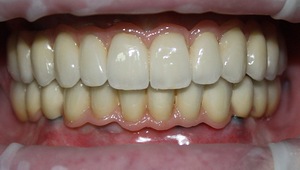
The complete absence of teeth, or complete adentia causes not only problems with eating, but also a violation of diction, face proportions, and is also one of the causes of constant discomfort of a person.
These are the main problems that reduce the quality of life in the presence of such an ailment.
More recently, the only way out of this situation was the use of removable dentures.
Of course, it is difficult to call an ideal removable jaw, because due to the lack of its reliable fixation there is discomfort when chewing, and there is also a risk of a removable denture falling out of the mouth.
Therefore, a technology that recently appeared, such as implantation in the complete absence of teeth, deserves special attention today.
Implant prosthetics with full adentia, both removable and non-removable, allows you to restore new teeth with high functional and aesthetic characteristics.
Kinds
Currently, there are several technologies for dental prosthetics on implants, so it is always possible to choose the most optimal implantation method for the patient.
Complete dental implantation
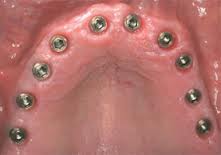
- This is a method in which an implant is implanted in place of each missing tooth.
- 14 implants are implanted in the upper and lower jaws, a crown is fixed on each of them, that is, a complete dentition is restored (with the exception of wisdom teeth).
- In some cases, it is possible to install 12 implants (second molars are excluded) on each jaw.
But such a technique is not suitable for every patient, since such a method requires a sufficient amount of bone tissue.
Nearby nerves can interfere with the installation of structures.
In addition, replacing all teeth with implants is an expensive procedure that may not be affordable for every patient.
Implant bridge
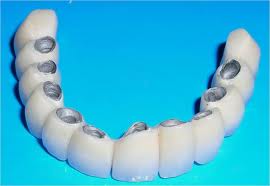
- This technique is similar to installing a traditional bridge.
- The only difference is that the support is not live teeth, but artificial ones.
- The number of implants to be installed can be different: usually you need to install from 6 to 8 implants - on the lower jaw and from 7 to 10 - on the upper.
Non-removable bridge prosthetics on implants with complete absence of teeth is one of the best solutions to the problem of complete adentia, since it is easier for the patient to tolerate and does not require the same costs as with full implantation.
Prosthetics "All-on-4"
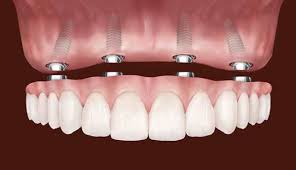
- In some cases, the implantation of a large number of titanium structures is impossible due to insufficient bone tissue, the proximity of the mandibular nerve or maxillary sinus.
- In such difficult conditions, implantation is carried out with the implantation of four implants on the upper and lower jaw.
- They are installed in place of the front teeth, observing a certain interval between them, while the extreme implants are implanted at an angle of 45 °.
A prosthesis can be either a removable or non-removable bridge-like structure.
In some cases, as a support for a removable prosthesis, a metal beam is fixed to the implants. This solution is quite popular due to its reliability and simplicity.
Removable prosthesis with a minimal number of implants
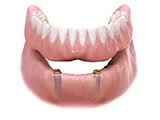
- If it is impossible to install even four implants, implantation of a smaller number (two or three) of structures is carried out with the installation of abutments with a spherical tip on them.
- Such a mount is more reliable, but at the same time makes it easy to remove it for hygiene.
- When installing a small number of implants, the removable structure can be fixed using the beam mounting method.
- The beam connecting the prosthesis and the implant provides a more reliable fastening than when using a spherical design and contributes to an even distribution of the masticatory load.
- The design is also easy to remove if cleaning is required.
Removable prosthetics on mini implants
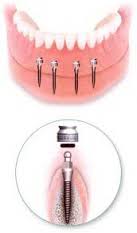
- It is used if there is a significant deficit of bone tissue and there is no possibility of its buildup for one reason or another.
- The advantage of mini implantation is that it has practically no contraindications and is a minimally invasive procedure.
- Mini implants differ from ordinary titanium rods in size (they are four times smaller) and the method of attachment.
- The mini implant has a round head covered by a rubber ring. Fastening occurs with the help of a latch, which is arranged like a button on clothes.
- Four to six mini implants are installed to fix the removable structure.
Implant prosthetics with full adentia, both removable and non-removable, allows you to restore new teeth with high functional and aesthetic characteristics.
Video: “What are mini implants”
Prosthetics
- Classical implantation. The implants are implanted in the jawbone. The engraftment lasts for six months, only after that a permanent dental structure is fixed on the abutment. In the presence of atrophic changes in bone tissue, implantation is performed before the implantation begins.
- Basal implantation. This is a modern implant placement technology. The duration of such a procedure takes no more than one week. Bone atrophy for this type of implantation is not a contraindication. For implantation, implants are selected that are suitable in size and quality of the skeletal system. The implantation of titanium structures is carried out at a certain angle in the deeper layers of bone tissue.
- Prosthetics with removable nylon dentures. This is the most affordable and comfortable way to prosthetics. They have one big drawback - they contribute to a decrease in the volume of bone tissue, because when chewing, the entire burden falls on the gums.
- Prosthetics using removable plate designs. Less comfortable compared to nylon dentures, but they are a cheaper option for prosthetics. During use, atrophic changes in bone tissue also develop.
Methods for fixing removable dentures
Spherical fixation
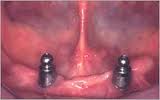
- The fixing elements consist of: spherical abutment and a plastic matrix.
- The spherical abutment is fixed on the dental implant, and the matrix is fixed on a removable structure.
- When fixing the prosthesis, the matrix is snapped onto the abutment.
- For secure fixing, the use of two spherical abutments is recommended.
Advantages of removable design with fixation on spherical abutments:
- Good enough fixation of the prosthesis.
- This prosthetics option is the most budgetary.
Disadvantages:
- The presence of large plastic parts of the structure. Long addiction and restoration of diction.
- Structural susceptibility to fractures and cracks due to the presence of plastic parts.
- The entire load goes to two implants, which leads to atrophy of the bone tissue around them, and then to their loss.
Beam fixing
More convenient and reliable design of all options for removable prosthetics with full edentulousness.
At least four implants located in the front of the jaw are recommended to be installed under the beam structure.
The fixing beam structure consists of two parts: a beam attached to dental implants and matrices made of plastic, which are in a removable structure.
Advantages of the beam fixation design for implants:
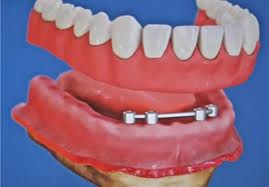
- The prosthesis is held stationary, which creates a feeling of comfort.
- Uniform distribution of chewing load on four implants, which does not adversely affect the jaw bone.
- The beam-fixed structure has a removable frame, which gives it durability and strength.
- Comfort state in use. No violation of diction.
Disadvantages:
- Fairly high price. The most expensive design of all removable structures in the complete absence of teeth.
- The presence of the need to remove the structure for hygienic care.
Fixed ceramic-metal construction with implant support
At least four implants are required, which will be the support for the fixed structure.
Benefits:
- There is no need to remove the prosthesis.
- Comfort when using.
- Desna and sky are completely open.
- No violation of diction.
- There is no violation of taste perception.
- Strength and durability of the structure.
- High esthetics.
Disadvantages:
- Fairly high price for the manufacture of structures.
- An allergic reaction to the metal is possible.
Fixed prosthesis based on zirconium dioxide
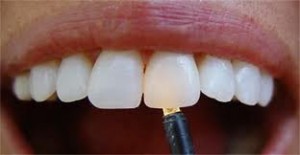
The most progressive method of prosthetics.
Benefits:
- Comfort design.
- Biocompatibility, hypoallergenicity.
- High aesthetics of the design.
- The lightness of the material.
- Strength and durability.
Clinical case
A 62-year-old patient came to the clinic. In one of the major clinics, a removable design on the upper jaw was made. The woman refused to use the design because of intolerance.
When using the prosthesis, nausea, unpleasant sensations appeared and complete discomfort was noted. The patient insisted on implantation with further prosthetics.
The examination revealed the presence of complete adentia of the upper jaw, as well as bone deficiency in the region of the maxillary sinuses. On the lower jaw there was an absence of incisors and the first molars.
Given the clinical picture, the inability to use a removable prosthesis and the wishes of the patient, it was decided:
- Install six implants - on the upper jaw.
- Two implants are on the bottom.
- Carry out further fixed prosthetics on zirconium dioxide.
The patient agreed with the proposed treatment regimen.
- At the first stage, six implants were installed on the upper jaw with a one-meter sinus lift. The fixation of the temporary dental structure. Two implants were installed on the lower jaw and a temporary prosthesis was fixed.
- The second stage of implantation was carried out four months later.Prosthetics were made with zirconium crowns.
The obtained results completely satisfied both the patient and all specialists involved in implantation and prosthetics.
Reviews
- Lost all the teeth on the upper jaw. The last three years I used a removable denture. Very uncomfortable. I went to the clinic. Conducted a survey, took pictures. Proposed prosthetics on implants. I was very afraid, but agreed anyway. The implantation was successful, fast and painless. Six implants were installed. Five months later, fixed prosthetics were performed.
- I have long been missing teeth on the lower jaw. For many years I used a removable denture, which has already become unusable. I went to the clinic, where I was offered to put mini implants. I agreed. Four titanium rods were implanted in my jaw and the prosthesis was fixed immediately after the operation. The operation went well. The implant engraftment was successful.
- I went to the clinic about a complete adentia of the upper jaw. After a full examination, the dentist advised an implantation followed by fixation of the bridge. I agreed. Installed 8 implants and a temporary prosthesis. Six months later, when the engraftment of titanium structures occurred, prosthetics were performed by cermet.